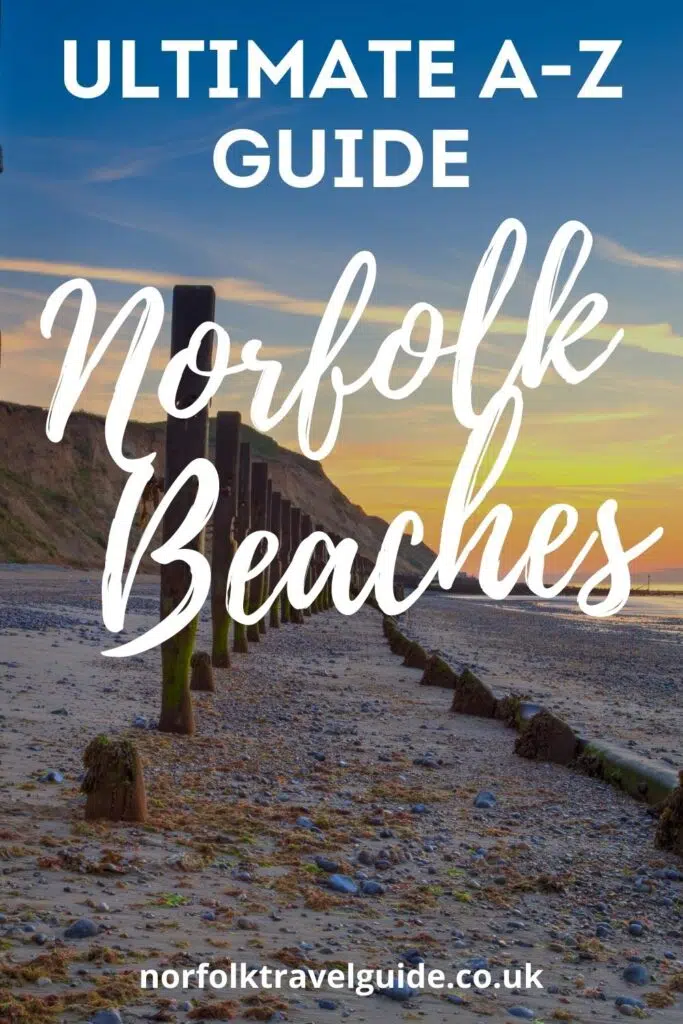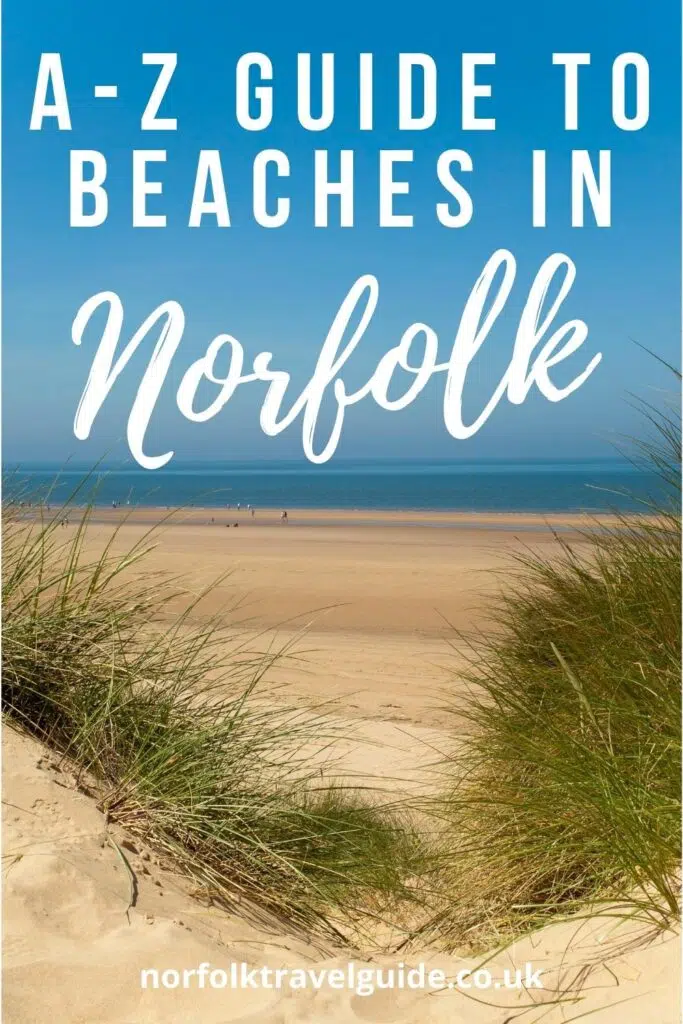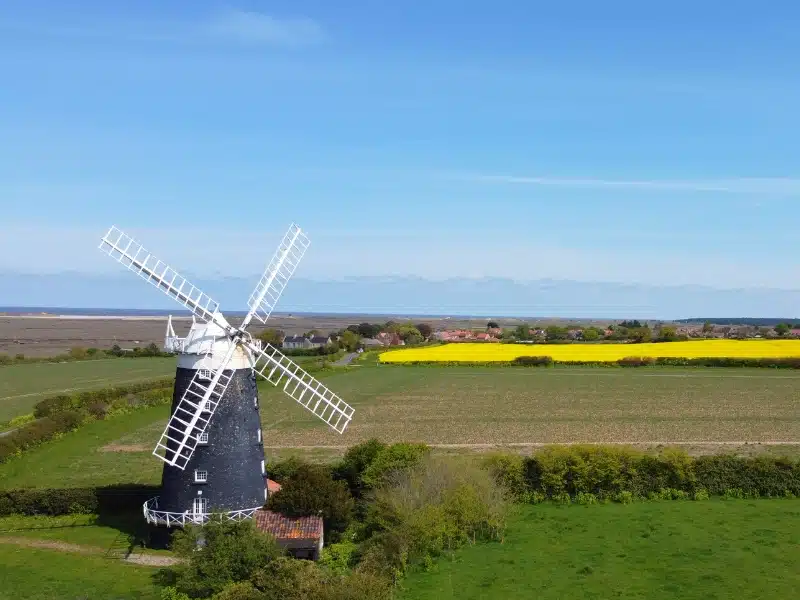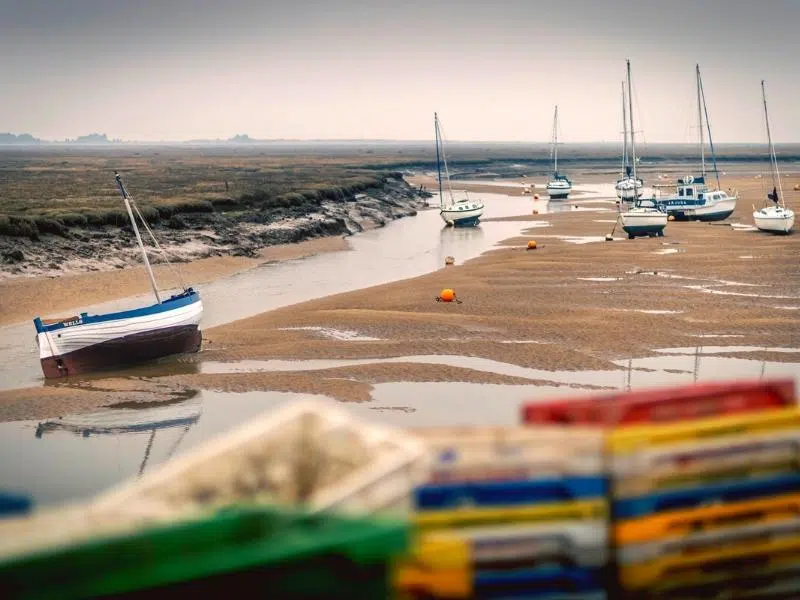With some of the best beaches in the UK along its glorious 84 miles of coastline, from fine golden sand to nature-filled marshes and mud flats, Norfolk’s beaches are one of the reasons visitors flock to the county.
I have a lot of happy childhood holiday memories of beaches in Norfolk. I grew up on the borders of the county and spent lots of long hot summers enjoying sand castle building, picnics, cold swims and family beach cricket along the coast.
Hopefully, I can share a bit of that love for the beaches of Norfolk by encouraging you to visit at least a few of them on your travels…
RELATED POST: The Ultimate Local’s Guide to Norfolk England
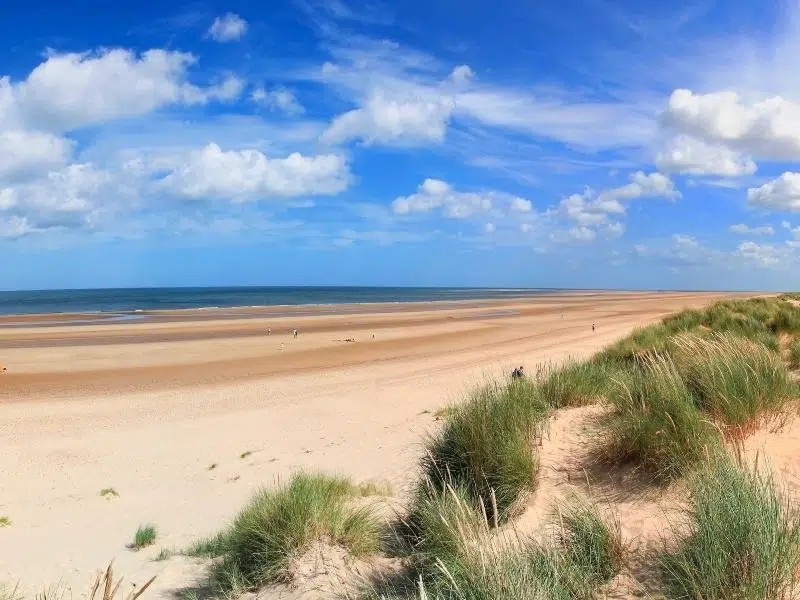
This post may contain affiliate links. If you book something I recommend, I make a small commission without affecting the price you pay!
Jump ahead to…
Looking for dog-friendly beaches in Norfolk? Find the best beaches for unleashed fun for your pooch in my guide to Norfolk’s dog-friendly beaches.
Bacton
Bacton is a lovely sandy beach that all but disappears at high tide. When the tide is out, the sand is firm underfoot making it perfect for long walks up and down the coast. This beach stretches all the way to Mundesley in one direction and Walcott in the other, and you can walk between the two on the pathway along the coast at the back of the beach, or along the beach itself at low tide.
Coastal erosion has always been an issue on this beach, and along this stretch of the Norfolk coast. You can see the reminders all around in the form of sea walls, rock armour and the distinctive wooden groynes which divide the beach up into sections and stop the sand from drifting.
Even though there are a couple of static caravan parks right behind the beach, it’s never busy here as there is no shortage of space! Like Horsey Beach a few miles down the coast, Bacton Beach is a good place to spot a seal or two.
Parking & Facilities
There is a small car park for the beach, and on-street parking if this is full. There are a few pubs and cafes, as well as public toilets, in Bacton village.
Dogs
Bacton Beach has dog restrictions on parts of the beach between 1st May and 30th September. This does mean in the high season you can’t take dogs on some parts of the beach. The nearest year-round dog friendly beach is Happisburgh.
RELATED POST: Norfolk Coast – 8 Amazing Ways to Explore
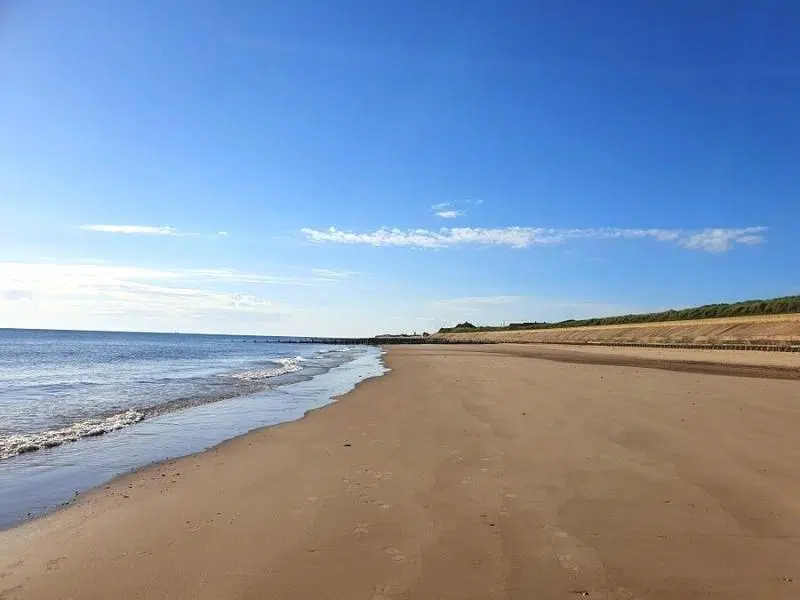
Blakeney Point
Situated in the North Norfolk Area of Outstanding Natural Beauty, Blakeney does not actually have a beach, although it does have breathtaking views of the North Norfolk coast.
The charming coastal village has its very own nature reserve and an atmospheric otherworldly watery landscape. The beach here is at Blakeney Point, a three mile sand and shingle spit, home to England’s largest colony of Atlantic Grey seals, and where over 2,000 seal pups are born every year.
There’s lots to do in Blakeney and the village can be busy in summer as it’s a perfect crabbing destination, and boat trips leave to take visitors out to Blakeney Point on seal-watching tours.
You can reach Blakeney Point by walking (not far enough to see the seals though) but it’s quite hard work and can be challenging, and potentially dangerous if you don’t get the weather and tides right. You can find out more about walking to Blakeney Point and the route here.
Parking & Facilities
Park at either Blakeney Carnser car park or Morston Quay car park to catch the boat to Blakeney Point, where parking is free for National Trust members.
There are toilets in both car parks.
Dogs
If you are planning the walk, there are no dogs allowed on Blakeney Point between 1st April and 15th August, to help minimise disturbance to ground-nesting birds. The beginning of the dog restriction zone is marked with signs along the width of the beach.
If you are planning to visit Blakeney Point by boat, dogs are welcome in the immediate area around the Lifeboat House but must be kept on a lead at all times.
RELATED POST: Blakeney Norfolk: All You Need to Know Before you Go
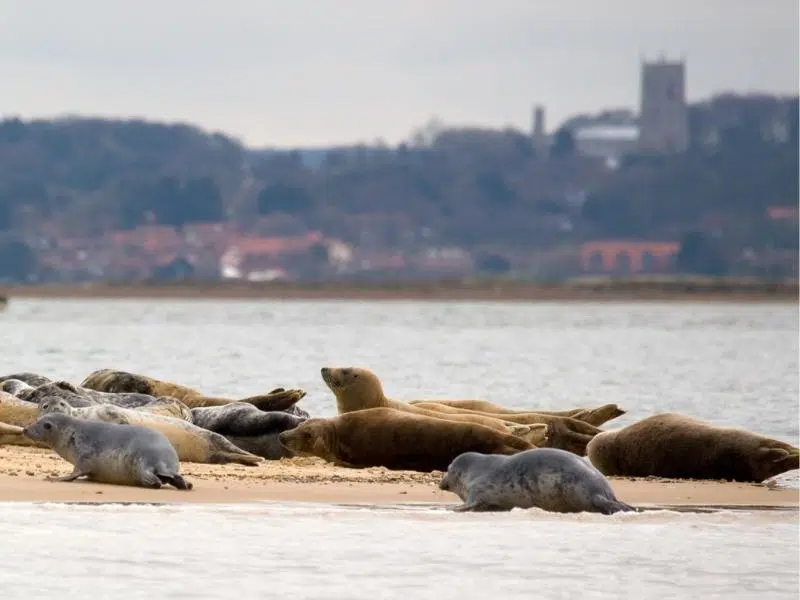
Brancaster
Managed by the National Trust, Brancaster Beach or “Branny” as it’s known locally, is blessed with soft sands perfect for picnics, sandcastle building and walking your dog. It’s also a popular spot with kite surfers, kite buggy fans and kite flyers (in restricted areas) and I learnt to fly a stunt kite here when I was a teenager. For me, it’s one of the best of the North Norfolk beaches.
Brancaster Beach also had its very own shipwreck, an amazing sight from the beach. Partially buried in the sand, the remains of the SS Vina were used by the RAF for target practice in preparation for the Normandy landings before she accidentally sank in 1944 and became stranded on the sandbank where she remained until 2022, when she was swept away.
The water at Brancaster recedes to leave shallow lagoons where young children can safely paddle and play – try and time your family beach visit as the currents can be strong when the tide is in. You can check Brancaster Beach tide times here.
Parking & Facilities
The car park at the end of Beach Road on the right is owned by the Royal West Norfolk Golf Club, and can accommodate up to 450 cars. There is a toilet block on the opposite side of the road, and a beach kiosk (open March to November) which sells beach toys, hot and cold drinks, ice creams and snacks.
The road to Brancaster beach car park can flood at high tide, and it’s usually too deep for cars to pass. Use the RWNGC website to check for the best time to visit.
Parking costs £5 for two hours and £9 for the day in summer. It’s £3 for two hours and £5 for the day in winter. There is a pay and display machine which takes cash and cards, and you can also use the flowbird app.
One of the best campsites in Norfolk, Deepdale Camping, is within a fifteen minute bike ride of this wonderful beach and makes a great base for a Norfolk holiday in Brancaster Staithe and Burnham Deepdale.
Dogs
Dogs with responsible owners are welcome on the beach. From May to September, there is a small dog-free zone to the left of the entrance once you walk onto the beach, but past that on either side of the entrance, dogs can run free all year round. Dog bins are available next to the toilets.
RELATED POST: Brancaster Beach – Complete Visitor Guide
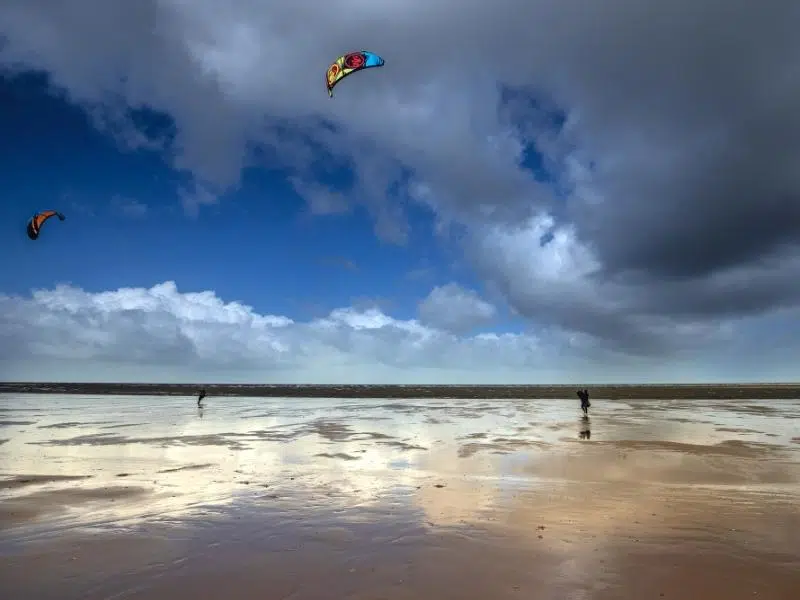
Burnham Overy Staithe
A fabulous unspoilt and secluded beach, Burnham Overy Staithe can only be reached by walking for a mile to get there. Once you step onto the beach through the gap in the dunes at Gun Hill, you soon realise that the walk was absolutely worth it! The huge expanse of beach stretches as far as you can see, and you can walk all the way to Wells along this unspoilt bit of Norfolk coast.
The walk may not be suitable for younger kids who just want to get stuck in with their bucket and spade. The walk will take you about 20 to 25 minutes, so make sure you pack everything you need for your beach visit. If the walk is not for you, head to nearby Wells Beach, where you can be toes deep in the sand within five minutes of parking the car.
The walk to the beach is along the raised banks of the Burnham Overy Footpath, a section of the Norfolk Coast Path, which is well-signposted from the village. You’ll pass boats, salt marshes, creeks, sand dunes and many birds along the way.
You could also hire a paddle board from North Norfolk Paddleboards in the village, and take a guided SUP tour out through the creeks to the beach.
Parking & Facilities
Parking is in and around the harbour at Burnham Overy Staithe. Most of the time, ‘the hard’ is the best place to park. This is a flat and hard piece of land on the harbour, but if there is a high spring tide, the hard floods and cars have been submerged here in the past! Check the tide times here. You can also park on the verges along the one-way system if you get here early enough.
There are no facilities at the beach but there are some good pubs and a few shops in the village.
Dogs
This is a very dog-friendly beach and is popular with dog walkers.
RELATED POST: Burnham Overy Staithe: Off-The-Beaten-Path Norfolk
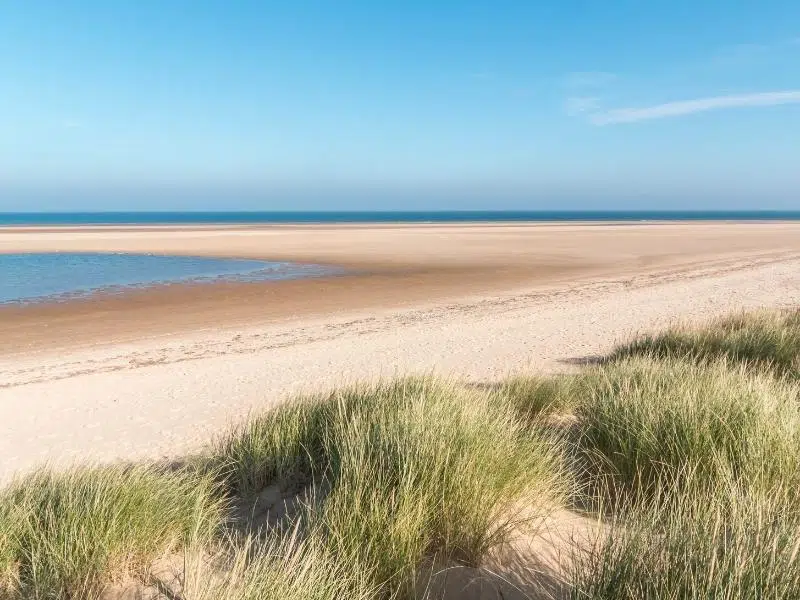
Caister-on-Sea
Sandwiched between Great Yarmouth and the Norfolk Broads, Caister Beach stretches for miles and is backed by sand dunes and sea defences. It is predominantly a sandy beach, but there are lots of pebbles mixed in. If it’s soft sand you’re after, the nearest alternative is Winterton Beach.
There is lots of interest here, with great views of the wind turbines of Scroby Sands Wind Farm, which have a sort of mesmerising appeal, as well as generating enough electricity to power 40,000 homes! You can find out more at the Scroby Sands Visitor Centre in nearby Great Yarmouth.
You’ll also find Caister Lifeboat station, a version of which has been here since 1791! The Lifeboat men of Caister have saved many lives at sea and you can find out more at the Caister Lifeboat Visitor Centre opposite the Lifeboat station.
The nearby Haven Holiday Park backs onto Caister Beach, making it the perfect place to spend a day if you’re staying there.
Parking & Facilities
Caister Beach parking is next to the Lifeboat station. There are no facilities.
Dogs
This is the ultimate dog-friendly beach, with no restrictions at all, whatever the time of year. Enjoy!
RELATED POST: 10 Brilliant Reasons to Visit Norfolk!
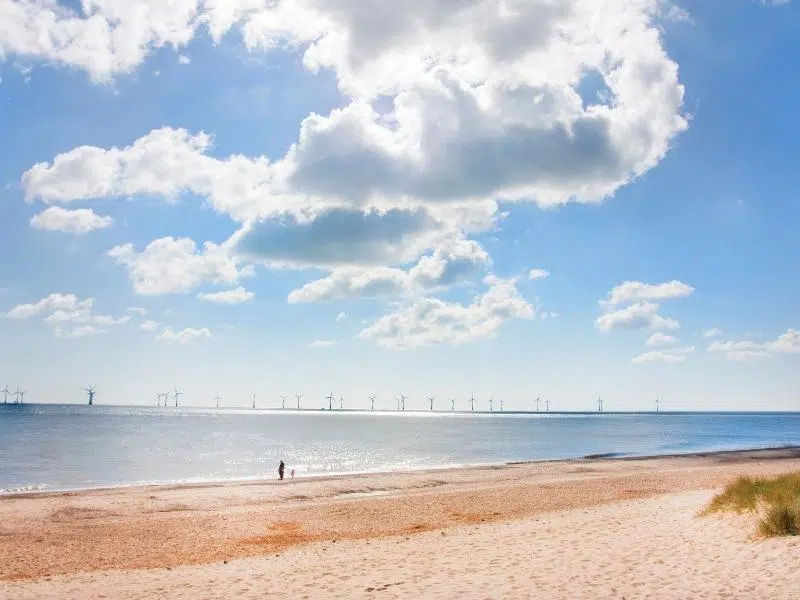
Cley next the Sea
Definitely not of the bucket and spade variety, Cley Beach (pronounced cl•eye) is a great place for walkers, birders and fishermen. If you’re looking for solitude, big skies and miles of shingle, then Cley is where you’ll find it!
Cley Beach has a deep drop-off into the sea, making it ideal for shore fishing, with flatfish like flounder and dab being common catches. You’ll also see tractors launching and retrieving boats up the shingle, that fish for crab and lobster off the beach.
The beach also borders one of the best bird-watching reserves in the UK, the Norfolk Wildlife Trust Cley Marshes, meaning the area is a haven for wildlife and nesting birds during spring and summer.
Cley Beach is on the Norfolk Coast Path, but if the 83 mile route is too long, there are lots of local walks like the Cley Windmill loop from Salthouse. This walk takes in Cley Marshes, the World War Two pillbox defence, Cley Windmill, the pretty village of Cley itself and the Norfolk Wildlife Trust Visitor Centre and cafe – you can find the route here.
Parking & Facilities
There is a small car park very close to the beach at the end of Beach Road. It’s free in the winter, but there is a parking charge in the summer unless you’re a member of the Norfolk Wildlife Trust, in which case the parking is free all year round.
There are no facilities at the beach.
Dogs
From April to August there is a total dog restriction to the west of the beach due to nesting birds, you can find out the exact restrictions here. Please remember that this beach is surrounded by nature reserves to the east and west, which means you must keep dogs under control.
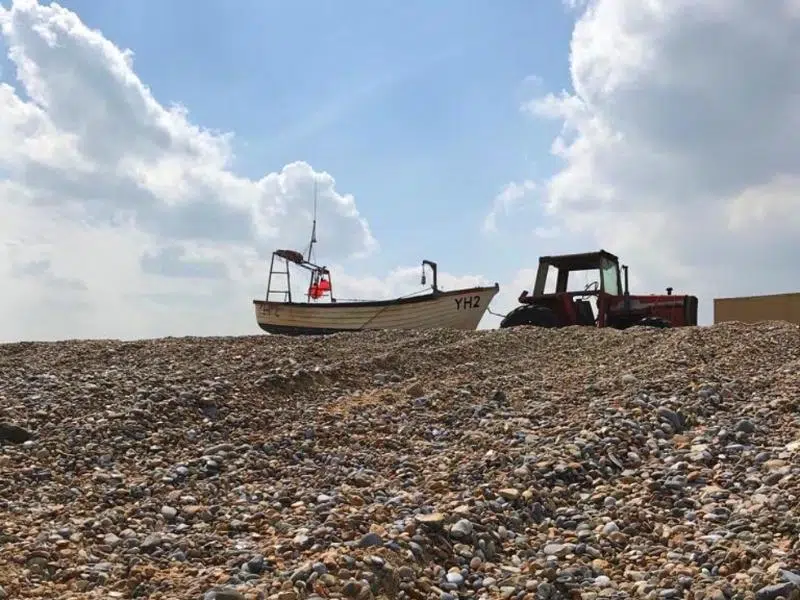
Cromer
One of the best Blue Flag beaches in Norfolk, Cromer Beach is long, sandy and safe for kids, with a lifeguard on duty in the summer months. The beach is popular for swimming and surfing and there are always lots of things to do in Cromer along the sands.
If you want to try your hand at surfing, take some lessons or hire equipment, you can find all of this at the Glide Surf School, right on the Esplanade in front of the beach.
Kids will love sand-castle building and rock pooling at low tide. You’ll always be able to find space to fly a kite and play beach cricket or volleyball.
There is also crabbing from Cromer Pier, the Lifeboat station and RNLI Henry Blogg Museum to explore, as well as wandering the Prom and tempting your taste buds with Cromer crab in the many independent Cromer eateries (including the all-important fish and chip shop) close to the beach.
Cromer beach also has a collection of colourful wooden Norfolk beach huts along the promenade on the east side of the beach which can be rented on a weekly basis from North Norfolk District Council. They make a great base from which to enjoy the beach and seaside town, and make your holiday planning a whole lot easier!
At the far end of the line of beach huts, you’ll find the Banksy “Cromer Crabs” artwork on the far side of the sea wall. Look carefully though, it’s actually quite small!
If you’re looking for a quieter alternative to Cromer beach, the adjacent beach of Overstrand is a short drive away. This is a peaceful and long stretch of beach without any attractions at all.
Parking & Facilities
There are plenty of car parks in Cromer, all of which require a short walk to reach the beach. You can’t park close to the beach unless you have a Blue Badge.
Runton Road NNDC car park is vast and a ten minute walk from the pier, but you can also access the beach using the path down to the Esplanade. Cadogan Road NNDC car park is a town centre car park with a ten minute walk to the beach.
There are lots of facilities in Cromer itself and public toilets along the Promenade.
Dogs
Dogs are banned from Cromer Beach from 1st May to 30th September, and they must be on a lead if they are walked on the Promenade during this time of year. If you do manage to walk your dog here, check out one of Cromer’s top cafes, The Doggie Diner, where you’ll find all sorts of treats for your pooch!
RELATED POST: Cromer Visitor Guide
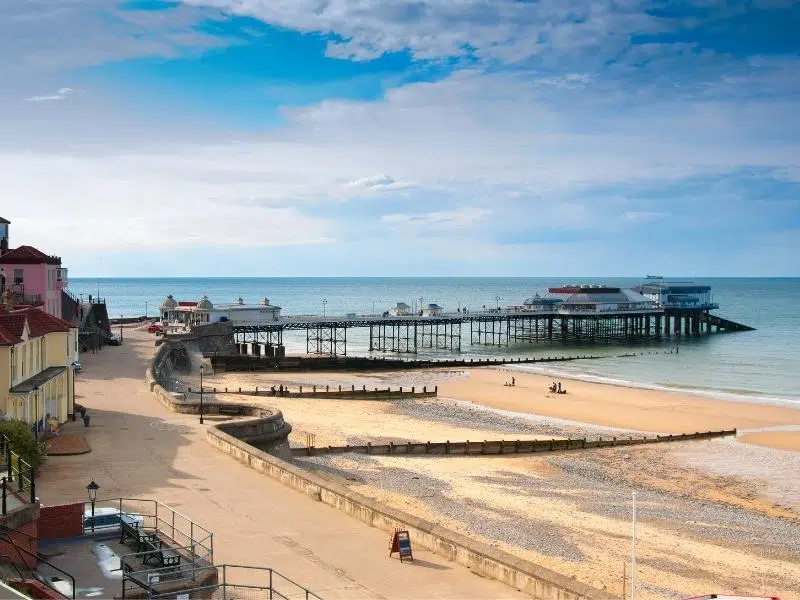
Eccles on Sea
The beach at Eccles on Sea is called Cart Gap Beach. It’s a bit of an unspoilt Norfolk gem and located at the end of a narrow, single-track lane on the beach, it’s definitely off the beaten path.
As with all the beaches along this bit of the North Norfolk Coast, Cart Gap is a beautiful sandy beach, with a few pebbles mixed in! It also sadly faces the same problems with erosion, and the beach is protected by wooden groynes and backed by a seawall.
Cart Gap is at one end of the Deep History Coast (the other being Weybourne), a 22 mile stretch of coastline which has revealed the most spectacular finds, and provided the earliest evidence for human occupation so far discovered in northern Europe.
The finds place early humans here in Norfolk some 350,000 years earlier than had been thought, at over 850,000 years ago! Look out for the Deep History Coast information board in the car park to find out more.
The beach car park is also home to the RNLI Happisburgh Lifeboat Station. The original lifeboat station was in Happisburgh itself but the site was destroyed by coastal erosion, which has escalated in recent years due to storms as a result of climate change.
Parking & Facilities
There is a pay and display car park at the top of the ramp which leads to the beach. There are public toilets in the car park.
A two minute walk from the beach is Smallsticks Café, where you can get hot and cold drinks, snacks and yummy homemade cakes.
Dogs
This beach is a dog walkers’ paradise and has to be one of the best dog-friendly beaches in Norfolk. There are no restrictions at any time of the year.
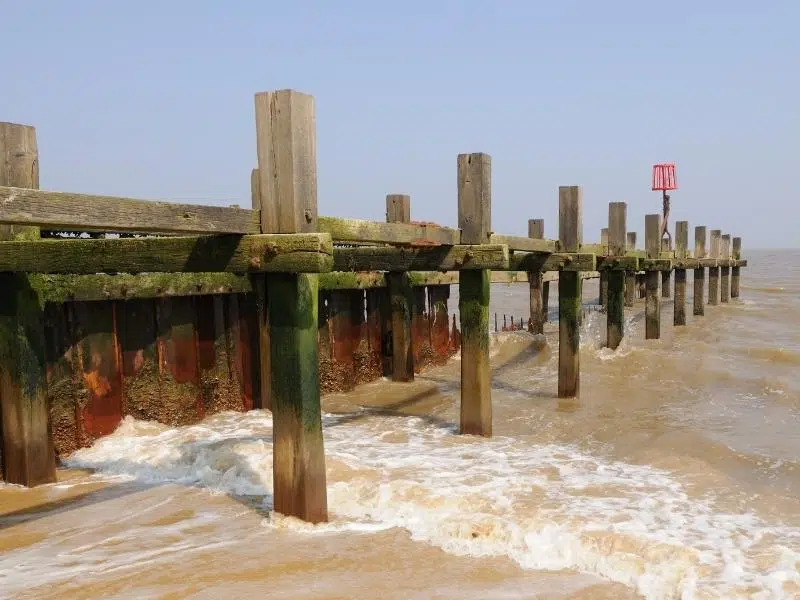
East Runton
Situated right next door to the seaside resort of Cromer, with its Victorian pier and esplanade, is East Runton beach. Despite their proximity, these are two completely different beaches.
East Runton is a long, sandy beach which is backed by sloping sandstone cliffs and the countryside beyond. You can catch a glimpse of Cromer’s pier in the distance, and walk there along the beach in around ten minutes.
Like West Runton, the beach here is of interest to geologists and fossil hunters alike, and both beaches share the largest chalk reef in Europe.
Towards the high tide mark, the beach is somewhat pebbly, however as the tide goes out acres of sand is revealed. Along with a seasonal lifeguard service and plenty of rock pools, East Runton is a family favourite for Norfolk visitors and residents alike.
On the cliff top overlooking the beach is the Windsurfers and Surfers Memorial with its figure of a surfer as a weather vane. The memorial is for local surfers and windsurfers who have died in various circumstances. The plaque reads “Waves come & go my friends, but your lights shine on”
Parking & Facilities
There is a small car park sandwiched between static caravan holiday parks, at the entrance to East Runton Beach. You’ll find toilets, cafes, pubs, restaurants and shops close by.
Dogs
There are no dog restrictions on East Runton Beach.
RELATED POST: Towns in Norfolk – 27 Towns to Visit in Norfolk
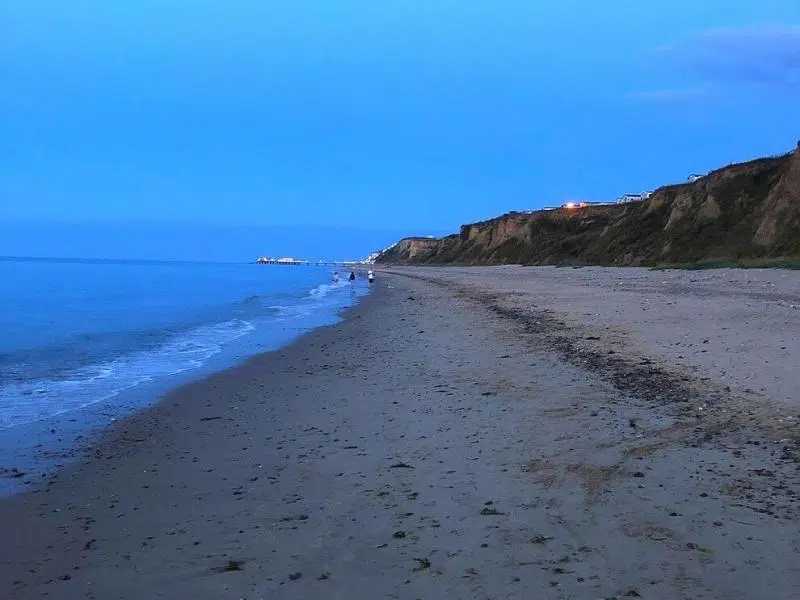
Gorleston-on-Sea
Just across the River Yare from Great Yarmouth in East Norfolk, is the much less visited Gorleston-on-Sea. Take your buckets and spades, or kites, to gorgeous Gorleston beach for a relaxed day out on the biggest and sandiest beach for miles around, which in 2023 was voted by TripAdvisor as the number one Best Beach in the UK and number twelve Best European Beach!
Gorleston Beach is a delightful two mile stretch of lifeguarded (in season) clean, golden sand which curves around the bay and when the tide goes out, a vast expanse of soft sand is revealed, perfect sand castle building material!
Have a go on the fiendishly difficult yachting pond, dip your toes in the paddling pool and explore the wide esplanade below the grassy cliffs before settling in for fish and chips and an ice cream for tea!
Parking & Facilities
There are two car parks for the beach, both of which are free. One is close to the Gorleston Pavilion Theatre, and another is halfway along the beach. There is also some roadside parking available along the road at the top of the beach, but this fills quickly in summer.
There are public and disabled toilets. There is also a cafe halfway along the promenade and deckchair hire in summer.
Dogs
You cannot take dogs onto the main section of the beach between 1st May and 30th September. Dogs are allowed on the beach south of the tennis courts all year round.
RELATED POST: Gorleston-on-Sea: A Traditional Norfolk Seaside Town
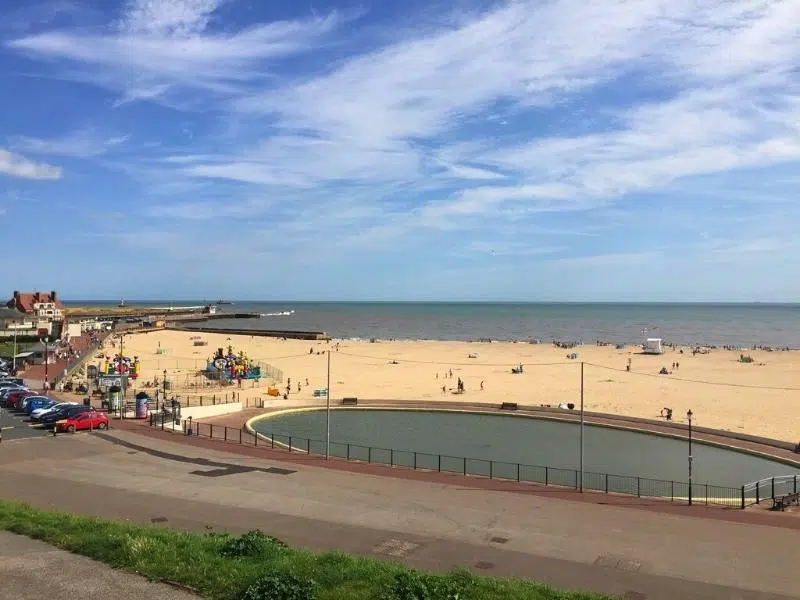
Great Yarmouth
Great Yarmouth Central Beach runs for nearly four miles along the whole of the town’s seafront, north from the River Yare to Caister-on-Sea Beach. Passing the Pleasure Beach and numerous other attractions, this is where holidaymakers come for a bit of respite from the lively attractions.
Busy in summer, and often deserted in winter, Great Yarmouth Beach is a long stretch of sandy beach which is perfect for a lounge or a stroll all year round.
In summer, you can board a boat at Britannia Pier to venture out to Scroby Sands to spot seals and visit the offshore wind farm, play crazy golf, ride donkeys, take water rides, bounce on a castle and all manner of other beach holiday activities!
If you fancy a swim, lifeguards operate along the beach between April and September.
Parking & Facilities
Paid parking is available along Marine Parade either within the designated beach car parks of North Drive and Euston Road or on the roadside.
The stretch close to town has lots of facilities like deckchair hire, access ramps for the disabled, play areas, shops, cafes, fast food outlets, ice cream sellers and public toilets.
Dogs
Dogs are not allowed on the main tourist sections between 1st May and 30th September, you can find maps showing which areas are restricted here. You must keep dogs on a lead at all times on the adjacent promenade.
RELATED POST: 13 Exciting Things To Do in Great Yarmouth

Happisburgh
Happisburgh (pronounced hayz•bruh) Beach has been devastated by coastal erosion, and the beach has been formed by years of battering by both sea and the wind, losing cliffs and even houses to the weather.
What remains is a beautiful and unspoilt bay with amazing views of the iconic red and white striped Happisburgh Lighthouse, the oldest working lighthouse in East Anglia.
To the north is Walcott and to the south is Cart Gap – you can walk the whole stretch between them when the tide is out, and even further if you have the legs!
Part of Norfolk’s Deep History Coast, Happisburgh Beach made international headlines in 2013 when a layer of sediment was exposed by the tide to reveal a set of footprints. In fact, 50 footprints were discovered, belonging to five adults and children making their way south – sadly they washed away within two weeks!
The footprints, dated to over 850,000 years old, along with the discovery of the West Runton Mammoth, have now made the Norfolk coastline an integral part of ancient British history, and you can search for your own fossils on the beach today.
Parking and Facilities
There’s a good beach car park here with a pay and display machine, public toilets, and a play area for the kids with wooden equipment. You can also visit the lighthouse easily from the car park – it’s just next door!
Happisburgh lighthouse, an incredibly photogenic Norfolk landmark, has open days where you can climb the 112 steps to the light for fantastic coastal views, and find out more about how the light is operated.
Dogs
Another ultra-friendly dog beach, with no restrictions whatsoever.
RELATED POST: Happisburgh: A Deep History Coast Village
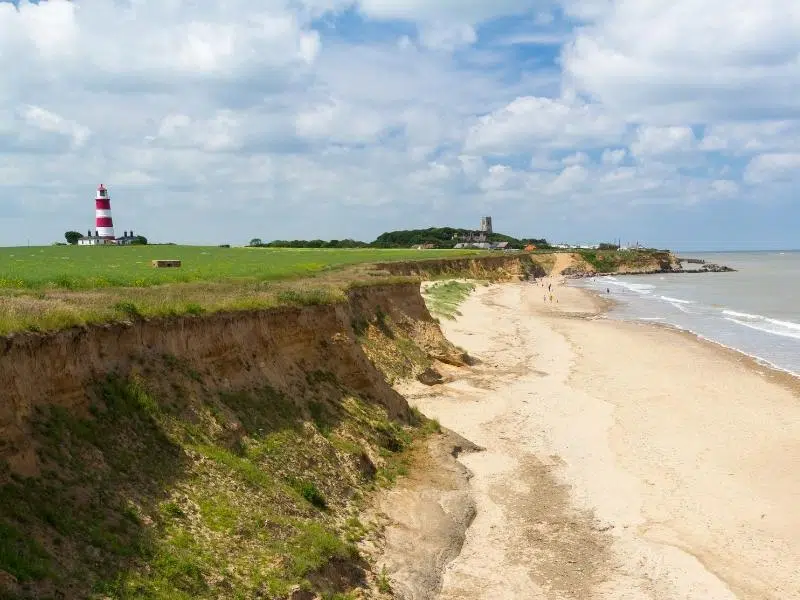
Heacham
Heacham in West Norfolk actually has two beaches, Heacham North Beach and Heacham South Beach. There are bands of sand but both Heacham beaches are predominantly shingle.
The south beach, known locally as ‘Stubborn Sands’ is quite rugged and good for long walks with a dog, sea fishing and romantic sunset strolls, as it’s located on the west coast of Norfolk. However, that also means the beach is on the Wash, so when the tide goes out, you’re left with estuary mud, not hard sand.
The north beach tends to be busier, with easy access to the promenade and holiday cottages beyond. Jet skis are also allowed to operate from here. The prom is stepped down to the beach, making a perfect place to perch with an ice cream and admire the sea view, without getting your feet in the shingle.
Heacham is one of the most popular static caravan and holiday chalet resorts on the Norfolk Coast, meaning you don’t have to get in your car and travel to get to the beach!
Parking & Facilities
Each beach has a designated pay and display car park, for which you can buy a rover ticket if you’re a holidaymaker. Find out more here.
Between the beaches are a couple of good cafes and there are public WCs at both beaches.
Dogs
Dogs are welcome on Heacham South Beach but must be kept on a lead during nesting season which is from 1st April to the 30th August, to protect the birds that nest directly on the shingle and sand.
There are no restrictions on Heacham North Beach.
RELATED POST: Heacham: Beaches & Family Fun in West Norfolk
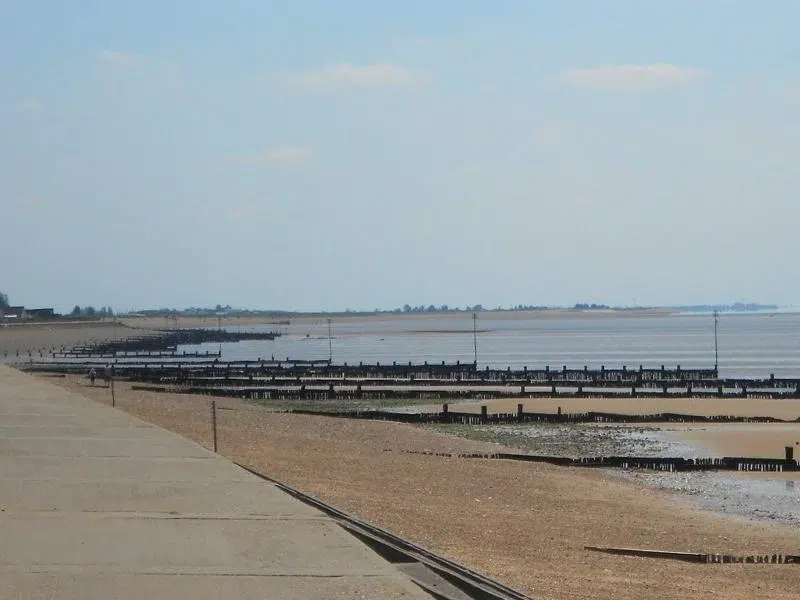
Hemsby
The spectacular wide and soft sandy Hemsby Beach, with its grassy dunes, is a popular choice with visitors all year round. With good water quality, a boardwalk for access and lifeguards in the summer, this is a family and child-friendly beach.
Hemsby itself is a lively village resort behind the beach with shops, amusements, attractions and cafes, a bit like a mini Great Yarmouth! Together with the beach, this makes Hemsby a wonderful family holiday destination, with plenty to keep kids of all ages happy.
If you need a break from all that, you can walk north along Hemsby Beach all the way to Winterton Beach, which is one of the highlights of the North Norfolk Coast and a great place for seal-watching.
Parking & Facilities
Paid parking is available in a large car park next to the beach.
There are lots of facilities just a stone’s throw from the sands, with eateries, amusements and public toilets in Hemsby village.
Dogs
Dogs are not allowed on the beach between 1st May and 30th September.
RELATED POST: Norfolk Theme Parks – Ultimate A-Z Guide
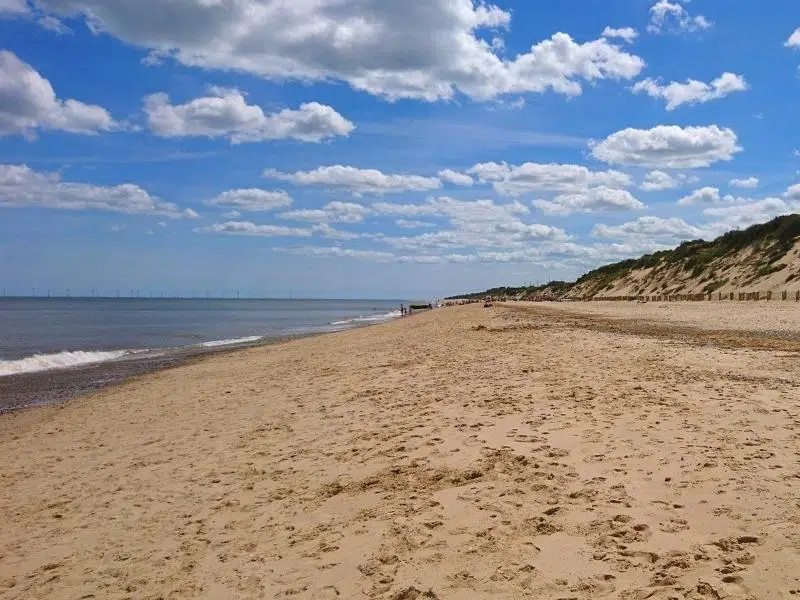
Holkham
Famous as the beach in the closing scene of the film ‘Shakespeare in Love’, Holkham Beach is simply vast and probably the best beach in North Norfolk.
Even in summer, you can find a quiet spot amongst the windswept tidelines, miles of dunes, pine forests and maze of creeks which make up Holkham’s nature reserve. This place is ripe for exploring by intrepid adventurers – young and old alike!
This is a remote beach, requiring a good walk from the car park. You won’t find cafes, ice-cream vans or shops selling buckets and spades here – or lifeguards. Make sure to organise well and take everything you need with you.
Bizarrely the tide is out more often than in, leaving wonderful hard sand, perfect for all those beach activities, even horse riding. So good is the beach for horses, the Household Cavalry exercise their horses on the beach every morning for a week in summer, from their barracks at Swanton Morley.
The whole area makes for a fantastic Norfolk day out, with Holkham Nature Reserve and the stately home of Holkham Hall close by.
Parking & Facilities
Parking for Holkham Beach is along either side of Lady Anne’s Drive in Holkham village, just off the A149, opposite The Victoria Inn.
Sitting at the top of Lady Anne’s Drive, The Lookout is a stunning modern building which blends into the landscape. You can get drinks, snacks and food here as well as using the loo!
Dogs
Dogs that are kept under close control or on a lead are welcomed on the beach. There are seasonal restrictions and dog zoning in place on some areas of the beach to help protect ground-nesting birds, you can find out more here.
RELATED POST: Holkham Beach – Complete Visitor Guide
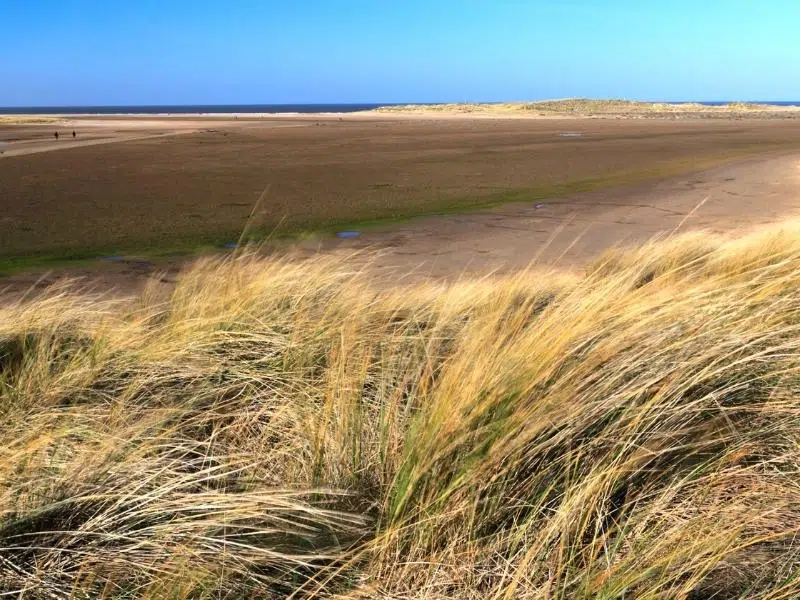
Holme-next-the-Sea
Holme is the beach of my childhood. I love the huge expanse of sand, the dunes perfect for playing hide and seek, and the happy family memories it holds for me.
Many prefer the more lively Hunstanton Beach, but for me, the far-reaching views and the soft sand make this one of Norfolk’s best beaches. It’s a bit of a hidden gem too, not many people head for Holme Beach – or not enough to make it feel crowded anyway!
Holme Beach had its fifteen minutes of fame in 1998 when an Early Bronze Age timber circle was discovered on the sands. An extraordinary find, the arrangement of 55 timber posts surrounding a huge stump that had been buried with its roots upwards, was called Seahenge, as it resembled the famous Stonehenge in Wiltshire.
When Seahenge was created around 2050 BC, the area around Holme was a salt marsh. Over thousands of years, the marshes were covered in peat beds as the sea encroached, and the peat preserved the timbers, keeping them whole.
The timbers were carefully removed from the sea, cleaned, and vacuum freeze-dried to protect them. The original upturned tree stump and many of the upright timber posts are now on display in a special exhibit in the Lynn Museum in nearby King’s Lynn.
There’s lots of interest on Holme Beach. To the west, you can see the white lighthouse of Old Hunstanton, and the colourful cliffs and beach in the distance beyond. To the east is nothing but endless skies and Thornham Beach. Behind you, is the Norfolk Wildlife Trust Holme Dunes Nature Reserve, a Site of Special Scientific Interest (SSSI), and an important area for nesting birds.
Holme Beach is also where the Peddars Way, which follows the route of an ancient Roman road for 49 miles to Holme from Knettishall Heath Country Park in Suffolk, comes to an end. The Peddars Way meets the Norfolk Coast Path here, and this latter route of 84 miles, wends its way from Hunstanton to Hopton-on-Sea, through the breathtaking scenery and landscape of the North Norfolk Coast Area of Outstanding Natural Beauty.
Parking & Facilities
The pay and display car park on Beach Road at Holme is easily accessible, but you do need to walk through the golf course and dunes to get to the beach – look out for flying golf balls! The walk takes around ten minutes over compacted paths and soft sand – make sure to take everything you need with you!
There is also parking closer to the beach at the Norfolk Wildlife Trust Holme Dunes Nature Reserve. The car park is free to NWT members, non-members will need to pay a parking charge.
Dogs
This is a popular dog-walking beach, with no restrictions at all.
RELATED POST: Holme Beach – Complete Visitor Guide
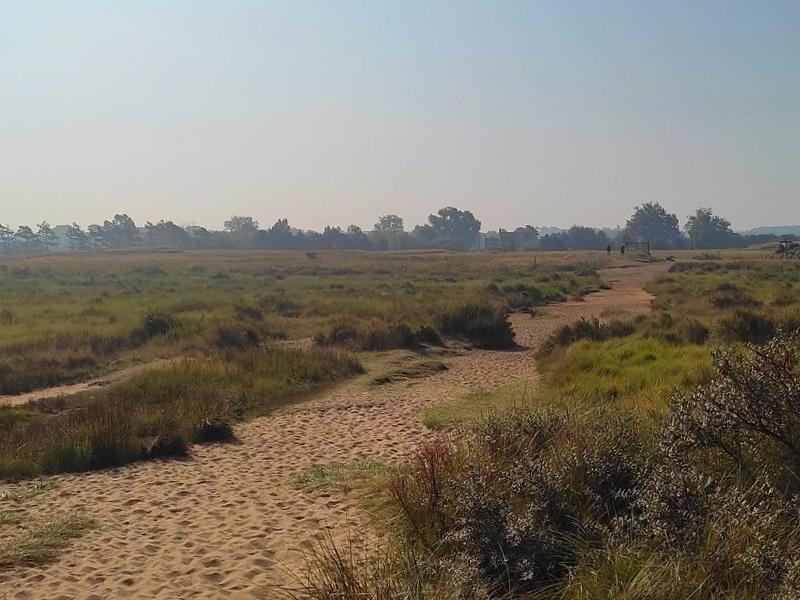
Horsey
A gloriously unspoilt stretch of sand and dunes, Horsey Beach is the point where the ferocious North Sea and the gentle Norfolk Broads almost, but not quite, meet.
For much of the year, Horsey Gap Beach is deserted, apart from dog walkers and those that want to get away from the hustle and bustle of Great Yarmouth or Norwich. But wait, there is an attraction here that draws 30,000 visitors a year in winter- grey seals and their seal pups!
Horsey Gap is one of the best places in the country to see the annual spectacle when hundreds of female seals come onto the beach to give birth and nurse their pups. The beach is out of bounds during this time, but viewing platforms along the beach are easily accessed, so you can ooh and ahh at the very cute seal pups!
To see the seals in action on the beach, visit between November and February. You’ll find volunteers manning the viewing platforms, they are very knowledgeable about the seals and love answering all your questions.
If you can’t visit in winter, spend time on this beach, or neighbours Winterton Beach and Waxham Beach, and you’ll see the seals popping their heads above water to have a nose at you. If you get in for a swim, you may well find they come within a few metres to check you out!
The sands here back onto Horsey Warren, the largest dune system in East Anglia, and home to a huge variety of wildlife throughout the year. Just inland is the very photogenic Horsey Windpump. Standing watch over the Horsey Mere, a climb to the top is rewarded with stunning panoramic views of the surrounding countryside and Broadland landscape.
Parking & Facilities
Horsey Gap pay and display car park is the best if you’re visiting the seals, with a ten minute walk when you arrive at the beach to reach the viewing areas. You can also use this car park if you’re heading to the beach.
The Horsey Windpump car park is owned by the National Trust, and parking there makes for a nice 1.5 mile Norfolk Broads walk to the beach if you’re up for a stroll.
The Nelson Head car park in the village is the other alternative, if you do park here, do the decent thing and have a drink in the pub!
There are no facilities at Horsey beach itself, but The Hatch food truck can be found in the car park, and just down the road from the Horsey Gap car park is the Poppylands Tearoom where you can get hot and cold drinks and snacks.
Dogs
Horsey Beach is very dog-friendly but keep your dog away from the seals in the water during the summer months. In the winter months, you won’t be able to walk on the beach, although you can take your dog, but it must be leashed and controlled.
RELATED POST: Horsey Beach – Complete Visitor Guide
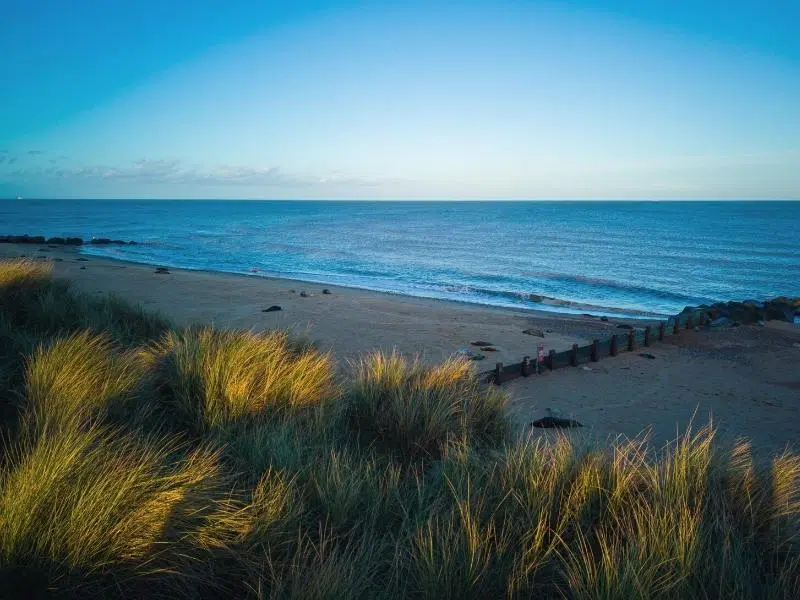
Hunstanton
Hunstanton is the only seaside town in Norfolk which faces west, even though it’s on the east coast! This means Hunstanton Beach is relatively sheltered from sea breezes and a great place to enjoy watching the setting sun.
Hunstanton actually has three beaches. If you want a proper sandy stretch, head to Hunstanton South Beach. Closest to the resort of Hunstanton, known locally as sunny Hunny, the south beach is perfect for families looking for a great sand-castle building beach and traditional beach activities.
The Victorian resort of Hunstanton was purpose-built in 1846 and, away from the amusement arcades, fairground rides and in-your-face noise and lights of the front has an old-world charm.
Hunstanton Beach to the north, often referred to as the main beach is a mix of amusements and attractions before the red chalk, white chalk and carrstone striped cliff face become prominent and is best for rock pooling, fossil hunting and dog walking outisde of summer.
The promenade is home to Hunstanton Sea Life Sanctuary and Aquarium, with its famous seal hospital, a mini-train to take visitors along the seafront, and a World War Two amphibious craft on which you can take a ride! The Norfolk Coast Path also starts its long route at the end of the North Promenade.
Further north still, the delightful beach of Old Hunstanton has a vast expanse of fine, golden sand when the tide is out and is considered the best kitesurfing beach and bodyboarding beach in the UK. Do check the tides here though, visitors can be caught out.
Parking & Facilities
Parking is fairly easy for the south and north beach. There are plenty of pay and display car parks in Hunstanton where you don’t have to walk far to reach the sands.
There are toilets and disabled facilities, as well as a beach office next to the Alive Oasis Leisure Centre.
For Old Hunstanton Beach, use the Clifftop car park, where there are also public toilets.
Dogs
Old Hunstanton and Hunstanton North Beach are dog-friendly with no restrictions. Dogs are not allowed on Hunstanton South Beach during the summer months.
RELATED POST: 21 of the Best Things To Do in Hunstanton
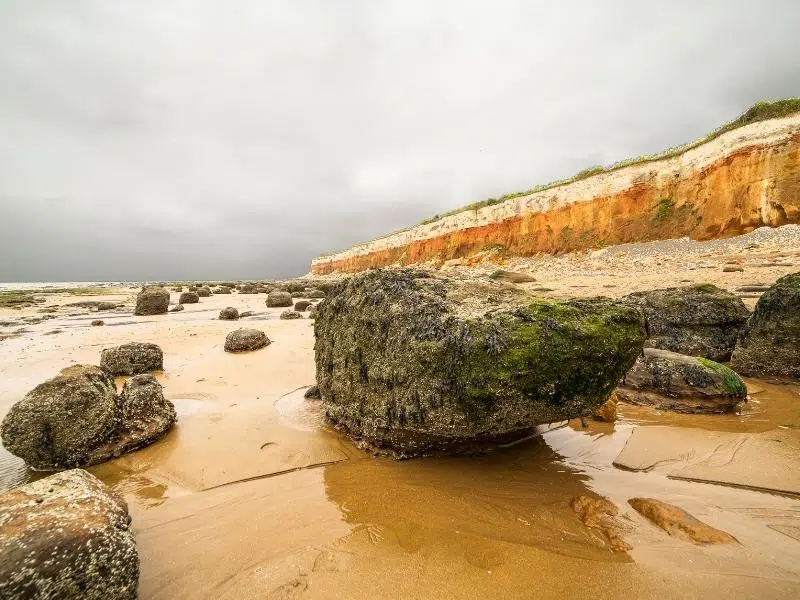
Mundesley
Located midway between Cromer and Happisburgh, Mundesley is considered by many to be one of Norfolk’s finest beaches. Long and sandy, the beach is backed by a promenade lined with brightly painted beach huts, which can be hired on a weekly let, and small cliffs.
This is a child-friendly beach with safe paddling and swimming at low tide, and lots for kids to explore around the groynes, which help prevent erosion and drifting sand. The beach has a lifeguard in summer and is usually given Blue Flag status, meaning the water quality is good.
Mundesley itself is a charming Victorian seaside resort, on a much smaller scale than its more famous neighbours. It’s the perfect spot for a traditional holiday, and a good starting point for local walking, including Paston Way and the Norfolk Coast Path.
The green on the cliffs above the beach is home to the Mundesley Maritime Museum, the smallest of its kind in the UK! The museum doubles up as a Coastguard Watch which is manned by volunteers. The museum is open daily between 1st May and 30th September. Next to this Norfolk museum is a clifftop memorial to the Royal Engineer Bomb Disposal teams that cleared the Norfolk coast of landmines after World War Two.
Parking
Pay and display parking is available nearby, with a short walk and steps down to the prom and beach. There is a public toilet in the car park.
Dogs
There are summer restrictions for dogs on Mundesley Beach, but once you head east or west from the prom, there’s lots of empty space for your pooch to run around outside of the restricted zone.
RELATED POST: Mundesley: Norfolk’s Best Kept Secret?
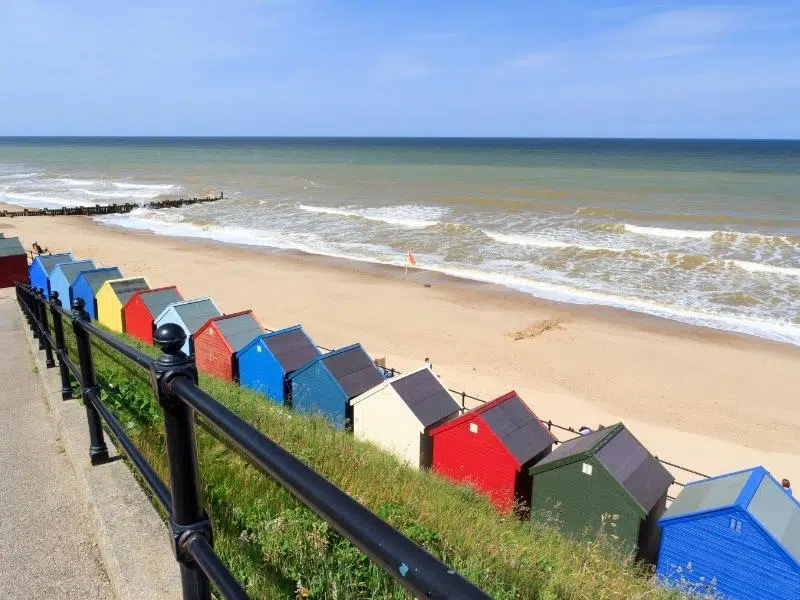
Overstrand
If you’re looking to escape the lively Cromer Beach, then Overstrand is the beach for you. Wide and sandy at low tide, this beach is just a good as Cromer’s, but much, much quieter.
Popular for sand castle building, surfing and swimming, when the tide comes in, it comes right to the sea wall, so check the tide times here, before planning a visit. If you’re looking for a beach where tides don’t really matter, then Holkham or Wells are the best nearby beaches for you.
Overstrand Beach is on the Norfolk Coast Path, and the walk from here along the path to Trimingham is one of the prettiest clifftop walks along the trail.
Parking & Facilities
Overstrand Beach car park sits above the beach, with access provided by a long sloping ramp down to the beach. There is a public WC in the car park, and usually, in summer you’ll also find the all-important ice cream van!
In the village of Overstrand, there are cafes, a pub and a village shop.
Dogs
Dogs are welcome on the beach and promenade for much of the year, however, from May 1st to 30th September inclusive there is a Public Space Protection Order (PSPO) that covers the main beach, promenade and access slopes.
RELATED POST: North Norfolk Coast – 14 Unmissable Highlights
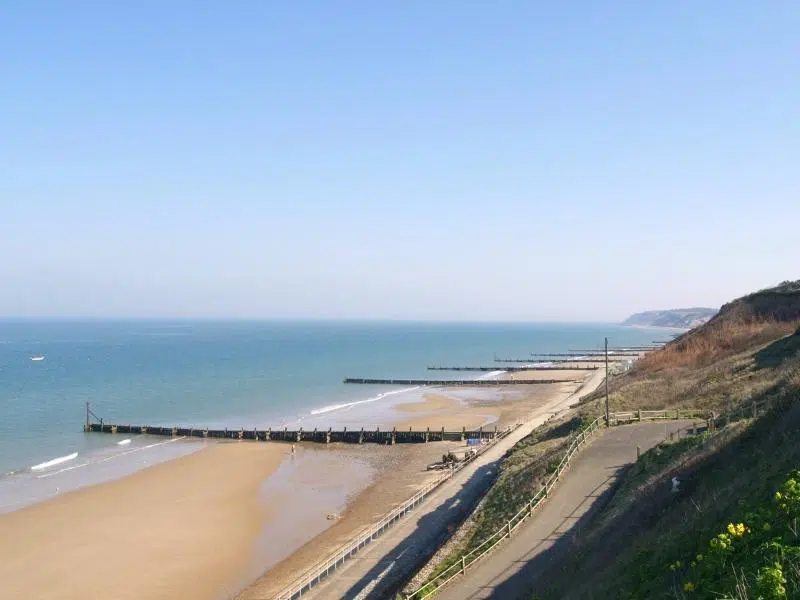
Scratby
Scratby Beach actually belongs to the civil parish of Ormesby St Margaret with Scratby, which is made up of the inland village of Ormesby St Margaret and the adjacent seaside resorts of Scratby and California. Scratby Beach and California Beach are really one large beach merged together.
The beach is a long stretch of sand and shingle beneath low sandy cliffs. Popular for fishing, swimming and surfing in the winter due to the good waves and easterly winds. When the conditions are right, there can be a large crowd of surfers and spectators on the beach.
Much of California Beach is backed by the Californa Cliffs Holiday Park, making this a busy beach in summer with families of holidaymakers.
The beach is also an ideal place for walking as it stretches along the coast to Caister Beach in the south, Hemsby Beach in the north and even on to Winterton Beach and the Winterton Dunes National Nature Reserve.
Parking
There is a small car park along Rottenstone Lane with a narrow sloping path and steps to the beach. There are no public toilets here.
In the village of Scratby, a short walk from the beach, there are a few small cafes, pubs and shops.
Dogs
Scratby Beach is dog friendly and has no restrictions at any time of the year.
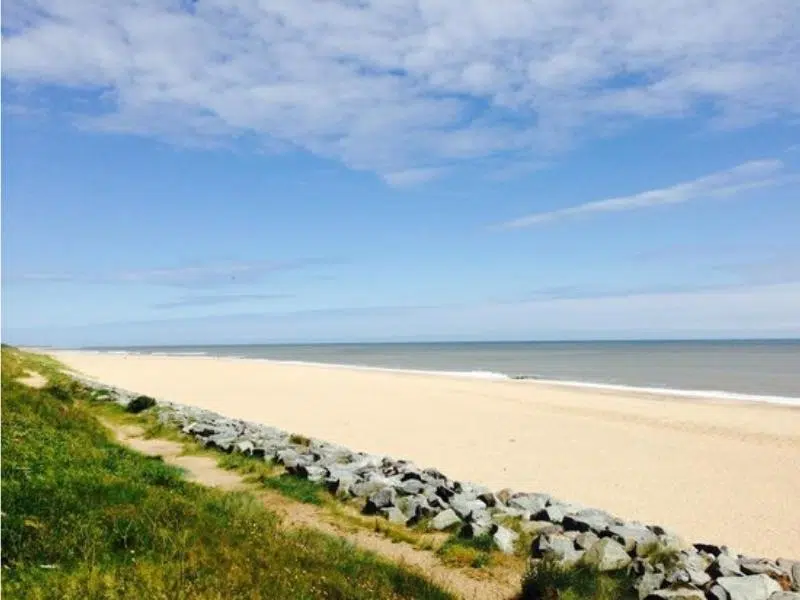
Sea Palling
The closest beach to Norfolk’s capital city of Norwich, Sea Palling is an excellent sandy beach with nine artificial offshore reefs created as part of a flood prevention scheme.
Backed by sand dunes, the series of curved beaches are often awarded Blue Flag status, and even when the tide is in, there is still plenty of beach for sand castle building and beach games. It’s usually pretty quiet, making this one of the best family-friendly beaches in Norfolk.
There are lifeguards on duty during the peak summer season and an Inshore Lifeboat based at Sea Palling Lifeguard Station right on the beach. There are also amusements, cafes and amenities set back from the beach, just enough to keep everyone entertained and fed, but not enough to make it into a really touristy beach.
This beach and village is really close to Hickling Broad, run by the Norfolk Wildlife Trust, so if a full day on the beach is too much for you, you can head just a few miles inland to the peace and tranquillity of the beautiful Norfolk Broads.
Facilities & Parking
There’s a large pay and display car park just a short walk from the sands.
Facilities include toilets, a pub, a few cafes, amusements, ice creams and even a fresh fish stall.
Dogs
There are dog restrictions in the summer, so head to Waxham or Happisburgh, which have no restrictions at all.
RELATED POST: A Local’s Guide to Norwich Norfolk
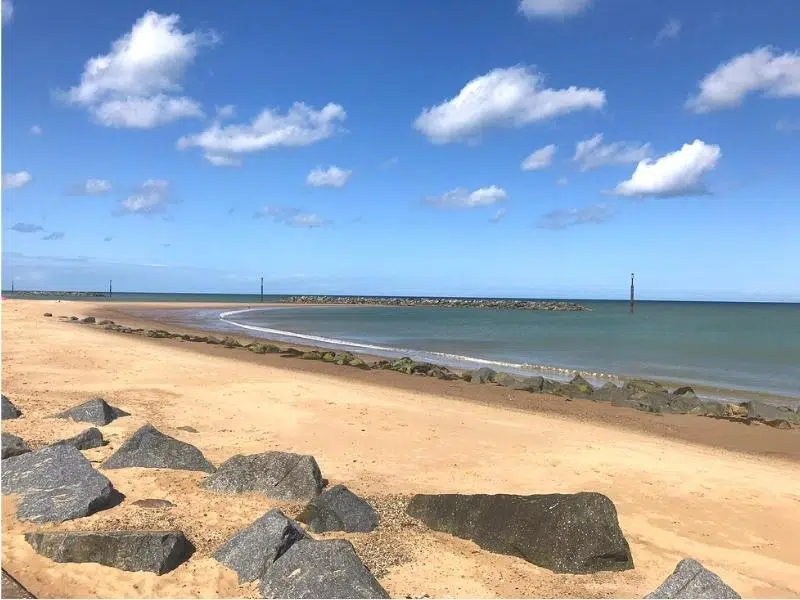
Sheringham
The award-winning Blue Flag Beach at Sheringham is made up of sand with areas of shingle and larger stones, as well as wooden groynes which divide the beach and reduce the erosion and movement of sand.
At low tide, there is plenty of soft sand for sunbathing, rock pooling and family games. However, as the tide comes in the beach is submerged, so check the tide times here before planning your visit.
The beach is very popular with families and RNLI lifeguards patrol here during the summer months. There’s also lots going on in the town, which sits behind the beach.
You’ll find a long promenade perfect for strolling, lots of independent cafes and places to eat, amusements, the Sheringham Lifeboat Station and the North Norfolk steam railway – enough to keep any family entertained!
Sheringham is a Norfolk seaside town with a fishing industry based on crabs, lobsters and whelks. This is celebrated at the annual Crab and Lobster Festival, held in May every year. There is no harbour so fishing boats are pulled up the sand by tractor, the same way that the lifeboat is launched!
Parking & Facilities
East Cliff NNDC car park looks down onto the beach and access is provided down the stairs to the prom. The other large car park is the Station Approach car park which is adjacent to the North Norfolk Railway. This involves a ten minute walk to the beach, but it’s a good alternative if East Cliff is full.
There are public toilets along the Esplanade, close to Sheringham Boating Lake. Beach huts are available for hire here.
Dogs
Sheringham beach is not dog-friendly during the summer months. The nearest all-year-round dog walking beach is Weybourne.
RELATED POST: 21 Amazing Things To Do in Sheringham
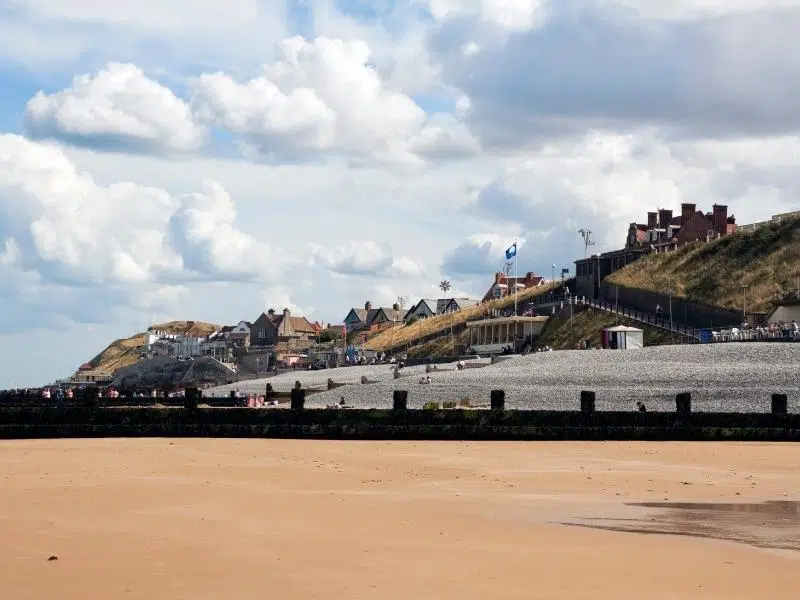
Snettisham
Snettisham Beach is the closest beach to King’s Lynn and one of three Norfolk west-facing beaches, the others being Hunstanton and Heacham. The shingle beach is vast, making it a great place for long walks, beach games and wildlife watching, as well as catching a wonderful Norfolk sunset.
The beach backs onto the Snettisham Coastal Park, a wild area full of heathland, marshland and reed beds that stretch all the way to Heacham, a great route for a peaceful and easy walk. The Coastal Park is adjacent to the RSPB Snettisham Reserve which hosts the incredible ‘whirling wader spectacle’, when tens of thousands of wading birds take flight when the conditions are right.
Snettisham beach is not really a bucket and spade destination, because when the tide goes out, it leaves mudflats rather than sand, which makes for very messy sandcastles! If you’re looking for a nearby sandy beach, try Holme or Brancaster.
Parking & Facilities
Snettisham Beach car park is right by the beach, making access very easy. There is a nearby pub and a fish and chip shop, but no public toilets – the nearest are at Hunstanton South Beach.
Dogs
Dogs are welcome on Snettisham Beach but must be kept on a lead during nesting season which is from 1st April to 30th August, to keep the birds that nest directly on the shingle and sand, and their eggs and young, safe.
RELATED POST: All the Best Things To Do in King’s Lynn Norfolk
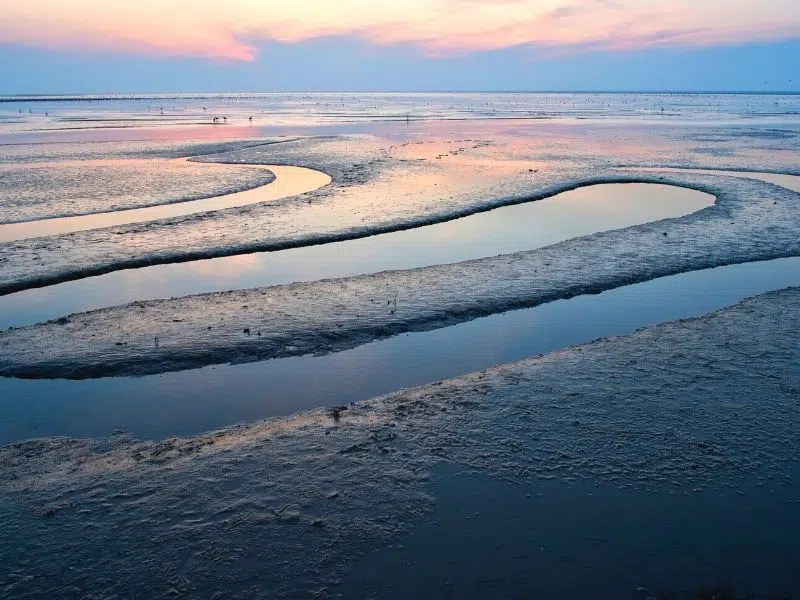
Thornham
Thornham Beach is my go-to beach when I want bracing sea air, a good walk and a big dose of solitude. Thornham is the most remote beach in Norfolk, making it perfect for my needs!
Set in the North Norfolk Area of Outstanding Natural Beauty, getting to the beach requires a walk of half a mile or so, and this is why the beach is never crowded.
The beach itself is covered with fine soft sand and a few small areas of shingle. When the tide comes in, you can retreat to the sand dunes, which remain dry and a great place to shelter from any wind. As with most North Norfolk beaches, when the tide is out, you’re left with an endless stretch of hard sand, ideal for walking and exploring the beach.
Thornham Beach is tidal so sandbanks do form. When you’re walking away from the beach, it’s easy to lose track of time and get stranded on one of the sandbanks by the incoming tide. There are no lifeguards on this beach, so make sure to check the tide times before visiting.
To get to the beach, take the raised bank from Staithe Lane along a small stretch of the Norfolk Coast Path, passing the Old Coal Shed (where smugglers used to operate) fascinating salt marshes and meandering creeks.
Keep going until you get to the wooden boardwalk, and you’ll see Broad Water pond on your left and a clear path to your right, which takes you through the huge expanse of dunes and onto Thornham Beach, which merges with Holme Beach to the west.
Parking & Facilities
There is no designated car parking for Thornham Beach, but there is a small amount of off-road parking along Staithe Lane, which runs alongside the raised path to the beach. Beware of spring tides in this spot, which are capable of covering a car!
There are no facilities, but at the top of Staithe Lane is the excellent Lifeboat Inn, the perfect place for a pie and a pint after your beach walk. If you have a table booked, check with the pub and you may be able to park and start your walk from there.
There is also parking closer to the beach at the Norfolk Wildlife Trust Holme Dunes Nature Reserve. The car park is free to NWT members, non-members will need to pay a parking charge – although the charm of this beach is really the walk!
Dogs
Thornham Beach has no dog restrictions, although it does border the Norfolk Wildlife Trust Holme Dunes Nature Reserve so it’s advisable to keep your dogs on a lead during nesting season.
RELATED POST: Thornham: A Hidden Corner in North Norfolk
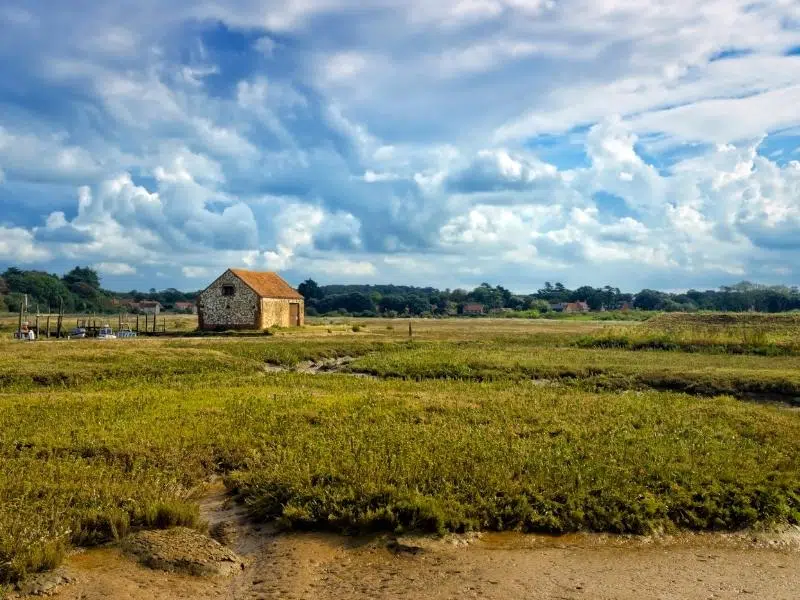
Titchwell
Titchwell is probably best known for the RSPB Titchwell Marsh Nature Reserve and its diverse habitats that include reedbeds, saltmarsh and freshwater lagoons where avocets, bearded tits and marsh harriers nest.
But Titchwell is also home to an often overlooked wide and sandy beach, backed by low sand dunes and with far-reaching views over the Wash. At low tide, the sand extends for miles in every direction, to Brancaster in the east and Thornham to the west.
The beach is home the demolished remains of a World War II control tower and the rusting bodies of two tanks, used for target practice by troops during the war. These reminders of Titchwell’s military past, along with the exposed and desolate nature of this beach, make it a haunting place.
Titchwell Beach is accessed via a public right of way from the RSPB car park, which is also the main West Bank path through the nature reserve. The walk is just under a mile along an easy track, which passes through freshwater and tidal lagoons, reedbeds, woodland and marshes.
Parking & Facilities
The RSPB car park is really the only place to park. It’s free for RSPB members and pay and display for everyone else.
RSPB Titchwell Marsh has a large visitor centre close to the car park, with a cafe, toilets, an information desk and picnic areas. You can take part in guided walks, follow nature trails and even hire binoculars here.
Dogs
Dogs are permitted along the West Bank path to the beach provided they are kept on leads. This is the only part of Titchwell Marsh Nature Reserve where dogs are allowed. Once on the beach, there are no restrictions, although some areas may be cordoned off to protect nesting birds.
RELATED POST: Norfolk Nature Reserves – Ultimate A-Z Guide
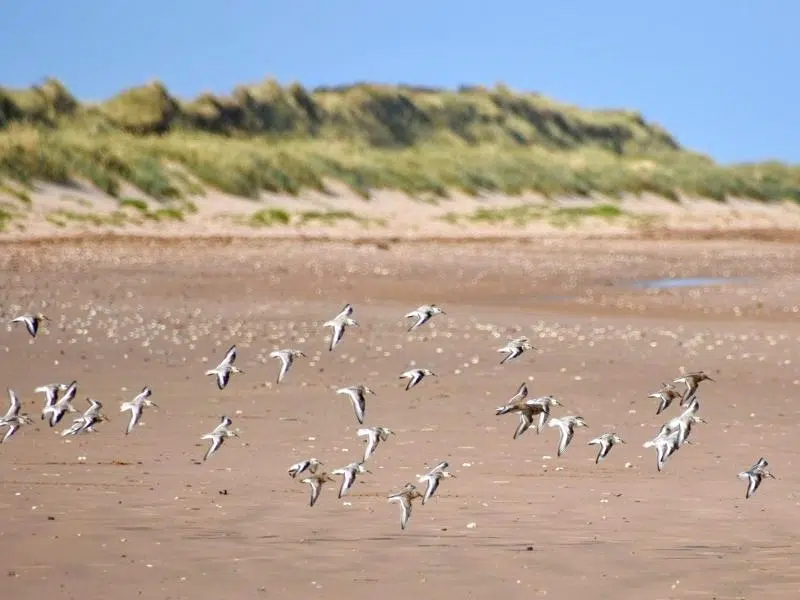
Trimingham
Trimingham is a secluded beach and definitely a Norfolk beach where you can escape the crowds. Located at the end of a steep and narrow lane, sandwiched between caravan parks, only the dedicated come here!
The beach is popular with watersports enthusiasts, dog walkers and sea anglers. It’s also a favourite haunt of fossil hunters due to the young age of the chalk cliffs that back Trimingham Beach.
The cliffs at Trimingham suffer from extreme coastal erosion and have had a couple of bad collapses in the past few years. A number of sea defences have been erected to help reduce this, but don’t get to close to the edge of the cliffs if you visit.
Parking & Facilities
There is a small car park at the top of the lane down to the beach, and more parking along the lane and at the bottom. There are no facilities.
Dogs
There are no dog restrictions on this beach.
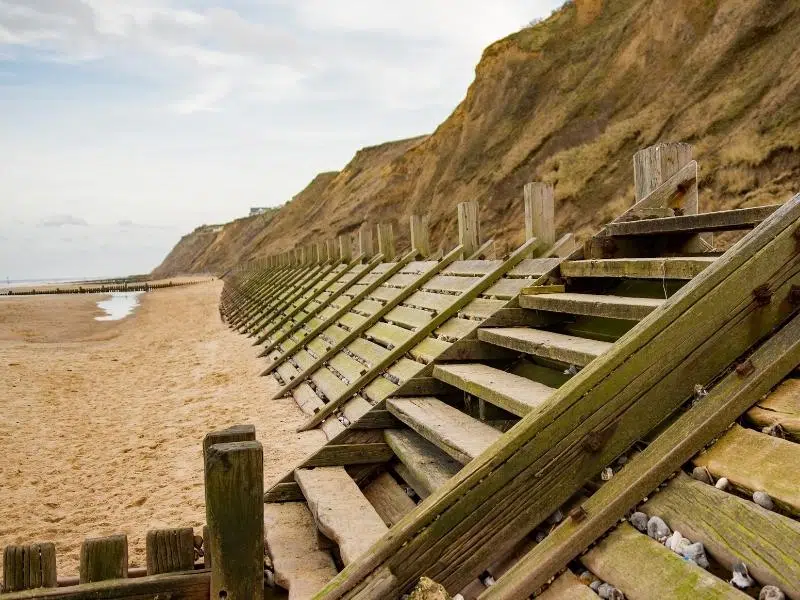
Walcott
This beach at Walcott is a pretty unassuming stretch of sand. The constant erosion this beach has suffered has shaped how it looks today – the fine sand divided up by wooden groynes and backed by a sloping, concrete sea wall.
Walcott village suffered badly during the storms of 2007 and 2013, and during the legendary North Sea flood of 1953, much of the village was lost to the sea.
You might notice something unusual if you visit Walcott Beach – the main coastal road actually runs right next to the beach. This is the only place in Norfolk where that happens. It makes access to this beach the easiest in the county. Don’t worry though, during severe storms, the road is blocked off.
Parking & Facilities
There is parking all along Coast Road, the B1159.
There are a couple of cafes and ice-cream shops along the seafront here along with toilets, and a really good fish and chip shop, the Kingfisher Fish Bar. Grab yours to take out and eat sitting on the sea wall opposite.
Dogs
There are dog restrictions on Walcott beach from 1st May to 30th September, between the main groynes. Other parts are dog friendly – see signs for details. During nesting season, which is March to August, dogs should be kept on a lead so that they don’t disturb nesting birds.
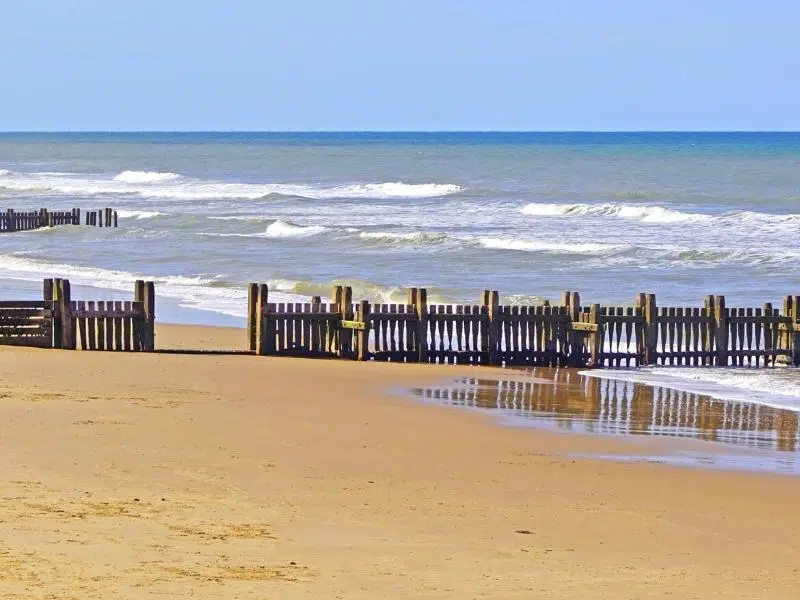
Waxham
The relatively undiscovered Waxham beach is delightfully off the beaten track and just down the road from the impossibly small village of Waxham, which is really just a crumbling church, a farm and the historic Waxham Great Barn, home to the excellent Dunes Cafe.
This stretch of coast falls within the Norfolk Coast Area of Outstanding Natural Beauty. As with near neighbour Horsey Beach, Waxham Beach is a great spot for seal spotting and seals have been known to investigate swimmers in these waters.
The most southerly section of the beach is known as Waxham Sands and there is a small holiday park there, alongside Waxham Summer Camp, a pop-up campsite on Poplar Farm. This area of the beach is usually busier than Waxham proper.
Parking & Facilities
There is no car park at Waxham Beach, but parking is allowed along the verges of Church Road, which encircles the small village. Other than the cafe, there are no facilities.
Dogs
Dogs are welcome throughout the year.
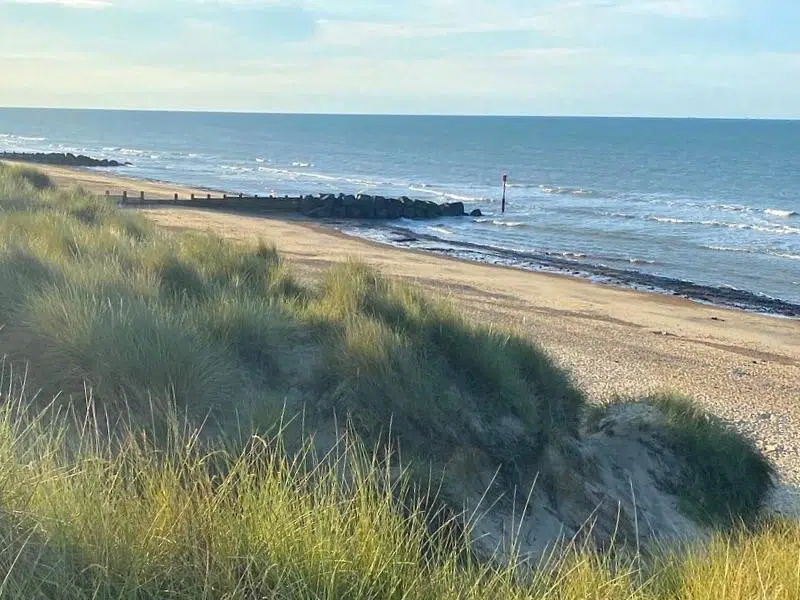
Wells-next-the-Sea
Award-winning Wells Beach is probably the most perfect Norfolk beach for families. With endless expanses of soft, golden sand just right for sandcastle building, raised and sheltered dunes to picnic in, space to fly a kite or play games, and the beautiful clear water of the North Sea, a day spent here is always a good one.
Add to that easy parking, the pretty harbour town of Wells (as it’s known locally) with its fine Georgian square and a good mix of independent traditional and contemporary shops to visit, and colourful beach huts like nowhere else in Norfolk, it’s no surprise that this is often touted as the best beach in the county.
There are also the gorgeously shady Pinewoods to explore, just on the other side of the sand dunes nearest the car park. The Norfolk Coast Path and Peddars Way run through these woods, crisscrossing from the trees to the beach. You can also follow the path all the way to Holkham Beach.
Parking and Facilities
There’s an excellent car park here – literally get out of your car, climb the wooden steps to the top of the dunes, climb down the other side, and you’re on the beach!
If the main beach car park is closed, park at Wells Town car park, at the start of Beach road, and walk or catch one of the Wells beach buses to the sands.
There is a cafe at the western side of the car park, which is a great backup if you forget a picnic item, or just fancy a cuppa and a slice of cake! There are also public toilets, and in the summer, an ice cream van – of course!
Dogs
Dogs are allowed on the beach at Wells all year round subject to certain restrictions. A dog-free zone operates for the first 200 yards of the beach from the main entrance so that people can dig in the sand without fear of finding something unpleasant, but there are no restrictions from the Pinewoods entrances.
RELATED POST: Wells-next-the-Sea Beach – Complete Visitor Guide
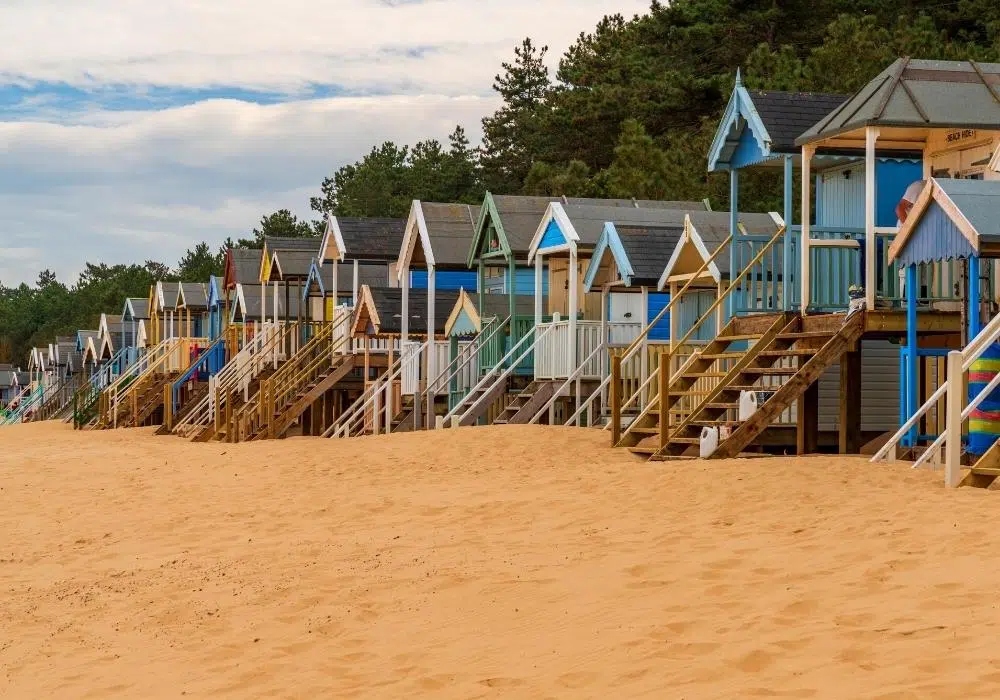
West Runton
Situated between the towns of Sheringham and Cromer the lovely sands of West Runton are often overlooked in favour of their more famous neighbours. Most people visit this beach for its history and geology though, and it’s an important location on Norfolk’s Deep History Coast.
Best known for the Steppe Mammoth found in the cliff face in 1990, and one of the oldest fossil elephants to be found in the UK, West Runton Beach is a popular place for fossil hunters. It’s great fun for kids to scrabble around looking for something interesting on the beach or in the many rock pools that form as the tide goes out.
Kids can also swim here in the Blue Flag waters and be safe under the eagle eyes of the patrolling lifeguards in summer.
A designated Site of Special Scientific Interest (SSSI), West Runton Beach is home to the largest chalk reef in Europe, making it popular with divers and surfers.
Just 1.5 miles inland is Beacon Hill, or Beeston Bump, the highest point in Norfolk at 105 metres above sea level. From here you’ll have a great view of the sea and the surrounding countryside. Walk to the top to find out about Beacon Hill’s World War Two history as a wireless interceptor station, and for a lovely wander around West Runton & Beeston Regis Heath.
Parking and Facilities
Head for the large Seaview car park on Water Lane at the top of the beach access ramp. You’ll also find toilets and the Seaview Beach Cafe here.
Dogs
West Runton Beach is dog friendly. During the summer months, there is a small restriction on the beach which must be adhered to by all dog owners. If you are unsure of the dog restriction, please ask at the Car Park Hut, Cafe or Lifeguard Station.
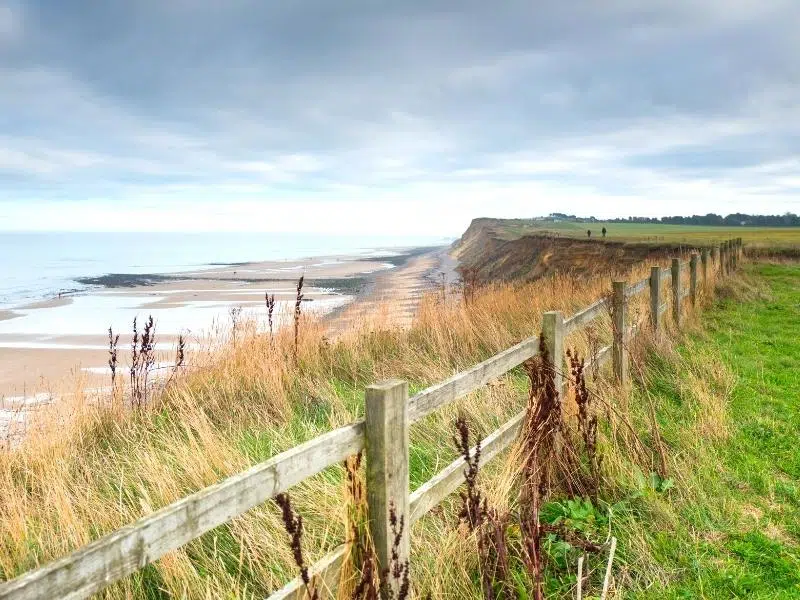
Weybourne
Just to the north of the charming village of Weybourne is Weybourne Beach. The steeply shelving pebble beach at Weybourne is said to have been the haunt of smugglers due to the ease with which they could land large boats full of contraband. These days you are more likely to see fishermen than smugglers!
Due to the shelving of the beach, there are always impressive waves here, and the sound of the sea against the pebbles of the beach is mesmerising. This is not bucket and spade territory, but the rounded pebbles retain and radiate heat from the sun, making it a great place for a spot of sunbathing with a good book. Although the shingle bank may be ideal for basking in the sun, it is not so good for swimming as it gets deep very quickly.
The clifftop next to the beach is a popular site for launching paragliders as the steady incoming wind prevents them from being carried out to sea, and provides enough consistent lift for extended meanderings up and down in front of the cliff face – it’s fascinating to watch.
Parking & Facilities
The car park is set right behind the beach, so it’s easy to get to. The section of the beach in front of the car park is situated in a gap between the cliffs on either side – the Norfolk Coast Path descends on one side, crosses the beach and ascends again on the other.
Dogs
This is a dog-friendly beach but quite hard going due to the pebbles underfoot.
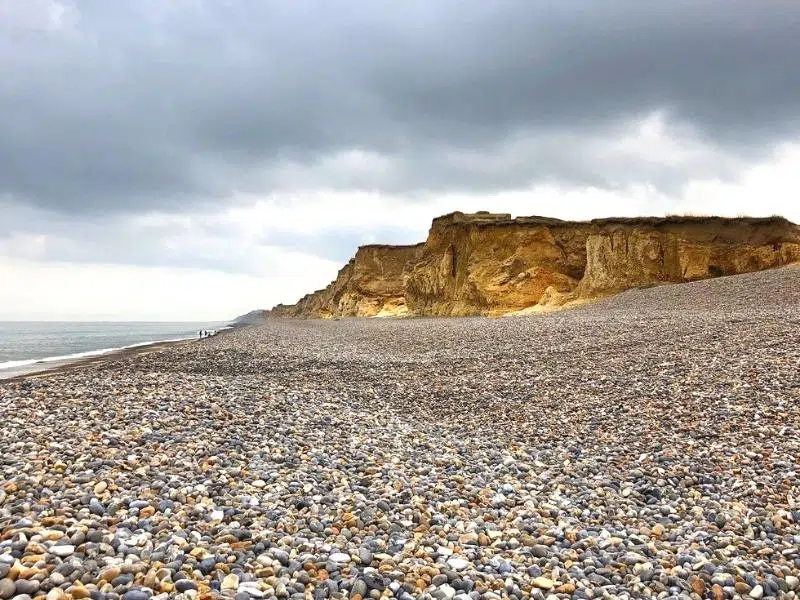
Winterton-on-Sea
There aren’t many places in the UK where you can see wild seals lounging on a beach, but we’re lucky enough to have several such places in Norfolk. The village of Winterton on Sea is at the further point south of North Norfolk and Winterton Beach is a cracking three mile stretch of sandy beach, backed by the Winterton Dunes National Nature Reserve and some of the finest sand dunes in Norfolk.
At the northern end of Winterton Beach is Horsey, home to an Atlantic Grey seal colony. You can see the seals swimming all along Horsey Beach and Winterton Beach year-round, as they pop up their heads to check out what’s happening on the beach.
In winter, around late October to early January, the female seals come onto the beach at Winterton and Horsey to have their pups. You are asked not to walk on the beach from November to late January or early February (depending on the year) to prevent the seals from being disturbed, but you can see the seals and their pups from the dunes and roped-off viewing areas.
During the breeding season, there are Volunteer Wardens from Friends of Horsey Seals helping to make sure the seals are allowed to give birth and mother in peace, and they are a great source of knowledge about the colony and seal behaviour.
In the summer months, this is a wonderful beach for walking, regardless of whether the tide is in or out. The beach is close to the pretty village of Winterton-on-Sea, where there are a couple of good pubs and cafes. Look out for the black-painted fisherman’s huts adjacent to the beach car park, they are very photogenic and I had heard they were listed, but have been unable to confirm that.
The landscape at Winterton Beach changes regularly as erosion takes its toll. The beach cafe was lost to the sea a few years ago, and last winter (2021) saw the temporary airstream cafe move inland several times as parts of the road and cliff-top car park took a battering and disappeared into the waves.
Parking & Facilities
The cliff-top parking is still there but seems to get smaller every year. Large vehicles like motorhomes are not allowed. There are public toilets at the entrance to the car park.
Dogs
This is a very dog-friendly beach in the summer, but the beach is closed to dog walkers in the winter to keep the seals and their pups safe.
RELATED POST: Seals in Norfolk – Where & How to See Them
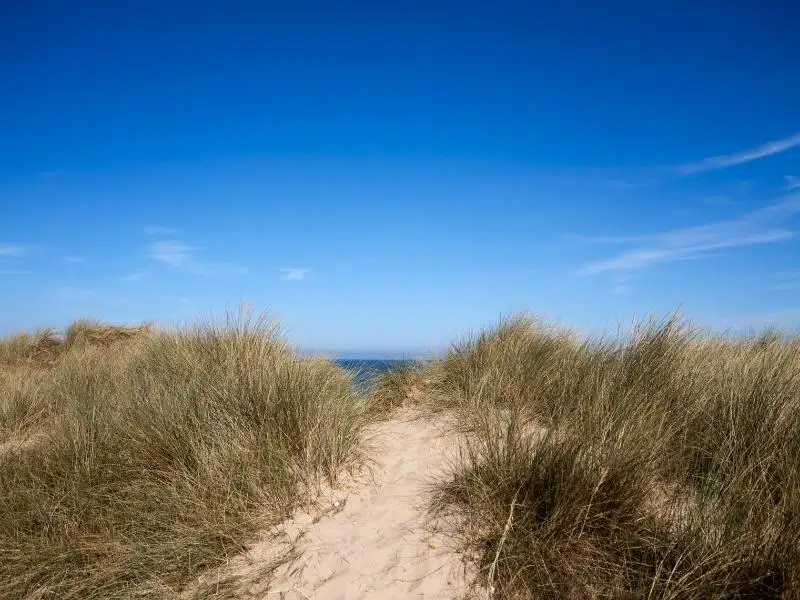
Norfolk Beaches Interactive Map
How to use this map – Use your fingers (or computer mouse) to zoom in and out. Click or touch the icons to get more info about a place, and click the arrow in the box top left to open the index. To add to your own Google Maps account, click the star next to the title of the map.
Have I missed any Norfolk beaches off this list? Scroll down to leave a comment…
Love it? Pin it!
